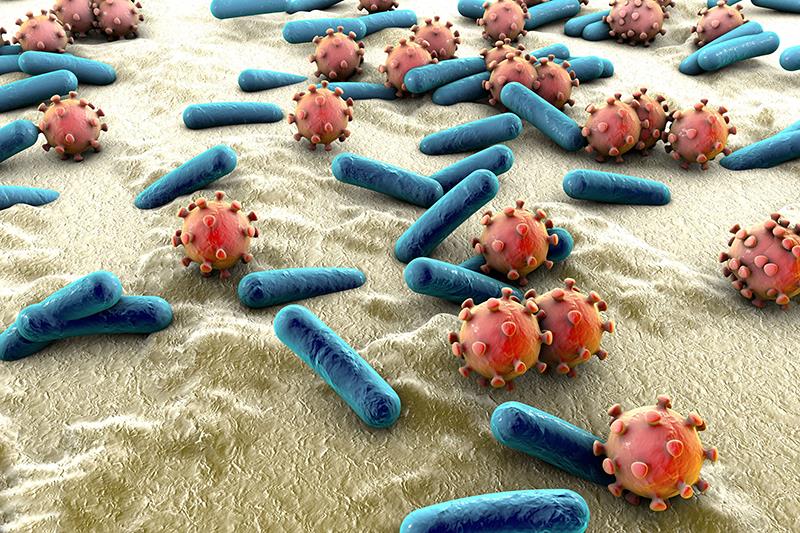Dual therapy as good as three-drug HIV regimen in patients coinfected with TB





In the treatment of HIV in individuals who are receiving rifampin-based therapy for tuberculosis, a two-drug antiretroviral (ART) regimen comprising double-dose dolutegravir plus lamivudine compares favourably with a three-drug regimen of efavirenz, tenofovir, and lamivudine in terms of suppressing viral load, as shown in a study.
In the modified intention-to-treat (ITT) population, the percentage of participants who achieved the primary outcome of virologic suppression (HIV-1 RNA <50 copies/mL) at week 24 was 62.1 percent with dual therapy vs 70.0 percent with triple therapy, with the difference not statistically significant (p=0.566), reported study co-author Dr Yinzhong Shen from the Shanghai Public Health Clinical Center in Shanghai, China. [ESCMID 2025, abstract L0022]
Results in the per-protocol (PP) set were similar, with the difference in the number of participants who achieved virologic suppression at week 24 not significantly different between the dual and triple therapy arms (72 percent vs 100 percent; p=0.072).
Stratified analyses showed no significant difference in response rates for virologic suppression at 24 weeks between the dual and triple therapy arms in subgroups defined by baseline viral load (≥500,000 copies/mL: 50 percent vs 40 percent; p=0.691; <500,000 copies/mL: 70.6 percent vs 100 percent; p=0.124) and baseline CD4+ counts (≥50 cells/µL: 58.3 percent vs 66.7 percent; p=1.000; <50 cells/µL: 64.7 percent vs 75.0 percent; p=1.000).
The number of patients who achieved good viral suppression (HIV-1 RNA ≤50 copies/mL) in the dual and triple therapy arms was 37.9 percent and 30 percent at week 12, 62.1 percent and 70 percent at week 24, and 69.2 percent and 62.5 percent at week 48, respectively, in the ITT population. The corresponding numbers in the PP set were 45.5 percent and 38.9 percent at week 12, 72 percent and 100 percent at week 24, and 90 percent and 100 percent at week 48.
Looking at the trends in HIV-1 RNA change from baseline, Shen noted that the viral load decreased rapidly within the first 24 weeks. The mean reduction in HIV-1 RNA from baseline was –6.1 log10 copies/mL with dual therapy and –6.0 log10 copies/mL with triple therapy in the ITT population, and –5.08 and –5.12 log10 copies/mL, respectively, in the PP set.
Meanwhile, the changes in CD4+ count indicated superior immune recovery in the dual vs triple therapy arm, according to Shen. From baseline, mean CD4+ counts increased by 140 vs 78 cells/µL at week 12, by 120 vs 101 cells/µL at week 24, by 155 vs 142 cells/µL at week 36, and by 157 vs 28 cells/µL at week 48.
In terms of safety, 12 tuberculosis-immune reconstitution inflammatory syndrome (TB-IRIS) events occurred, including nine in the dual therapy arm and three in the triple therapy arm. These events did not lead to treatment discontinuation, Shen said.
Two serious adverse events were reported in the dual therapy arm, but neither of them was directly related with antiretroviral drugs.
Taken together, the present data point to the value of double-dose dolutegravir plus lamivudine as an alternative to triple therapy in HIV-infected individuals who are receiving rifampin-based tuberculosis treatment, according to Shen. This holds important clinical implications given the “intricate interactions” between antituberculosis and ART drugs, as well as the “puzzling and tricky” TB-IRIS events, he added.
The study included patients with HIV–TB coinfection who were naïve to ART and were starting ART 2 weeks after initiating rifampin-based antituberculosis treatment. These patients were randomly allocated to the dual therapy arm (dolutegravir at 50 mg every 12 hours or 100 mg daily plus lamivudine) or the triple therapy arm (efavirenz 600 mg plus tenofovir plus lamivudine).
A total of 49 patients (dual therapy arm n=29, triple therapy arm n=20) who received their allocated treatment and completed the 24-week visit were included in the ITT population. Baseline characteristics were similar in the two treatment arms, including age (median 49 and 45.5 years), sex (86.2 percent and 90.0 percent male), HIV-1 RNA (5.5 and 5.2 copies/mL), and CD4+ count (45 and 58.6 cell/µL).
The PP set comprised 25 patients in the dual therapy arm and 13 in the triple therapy arm.